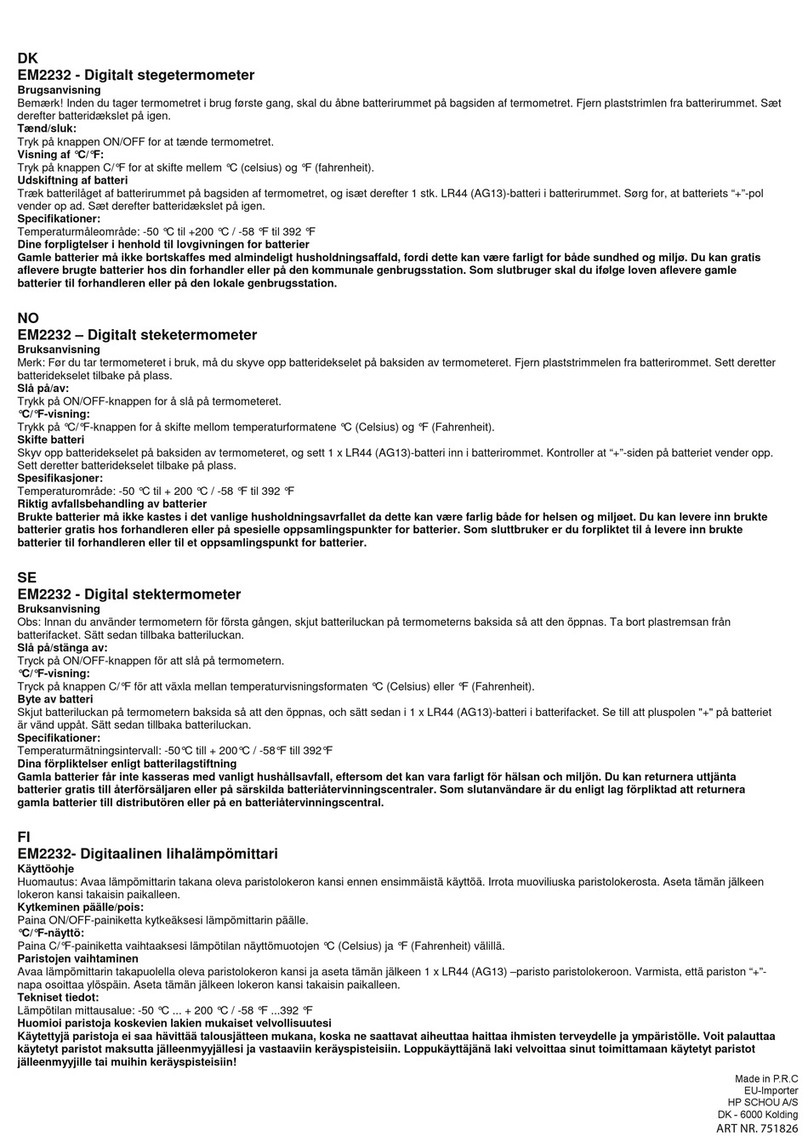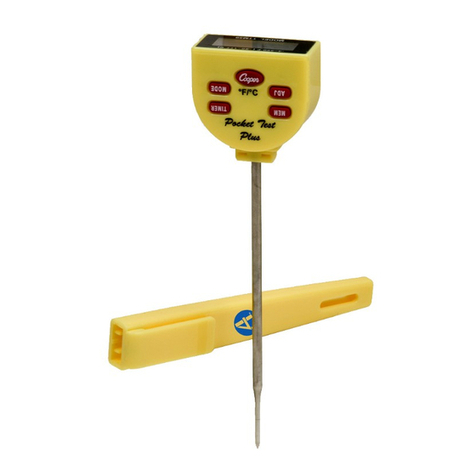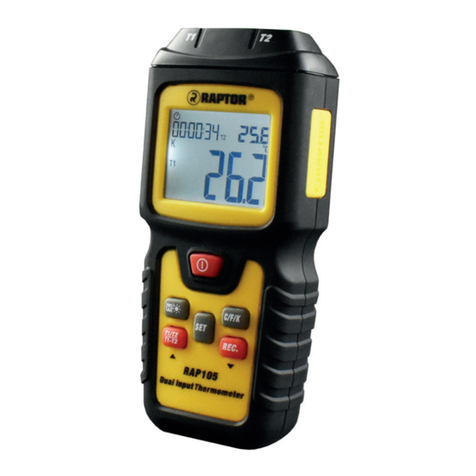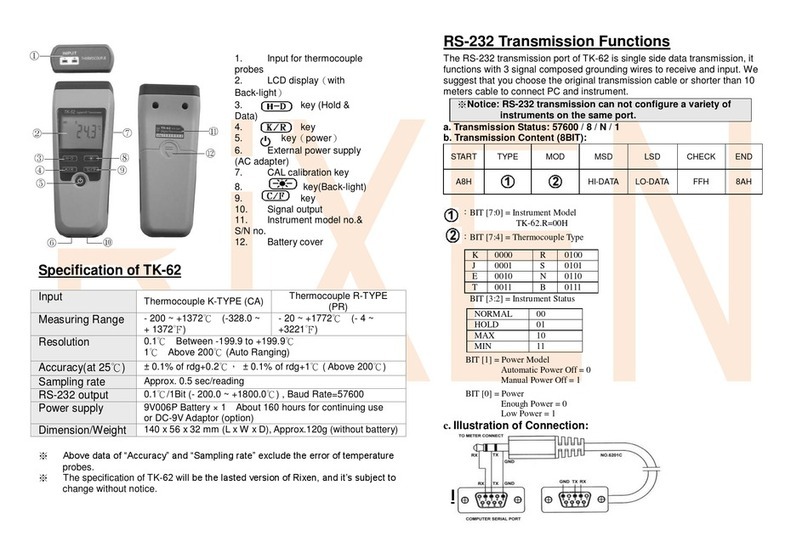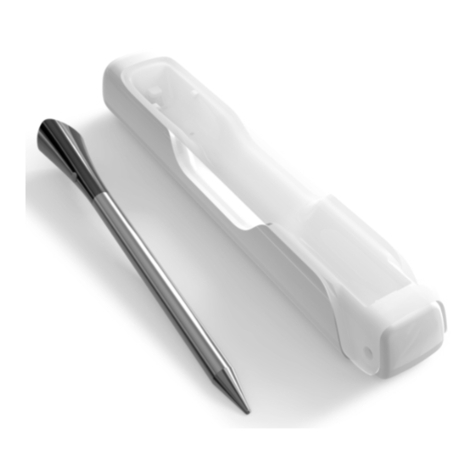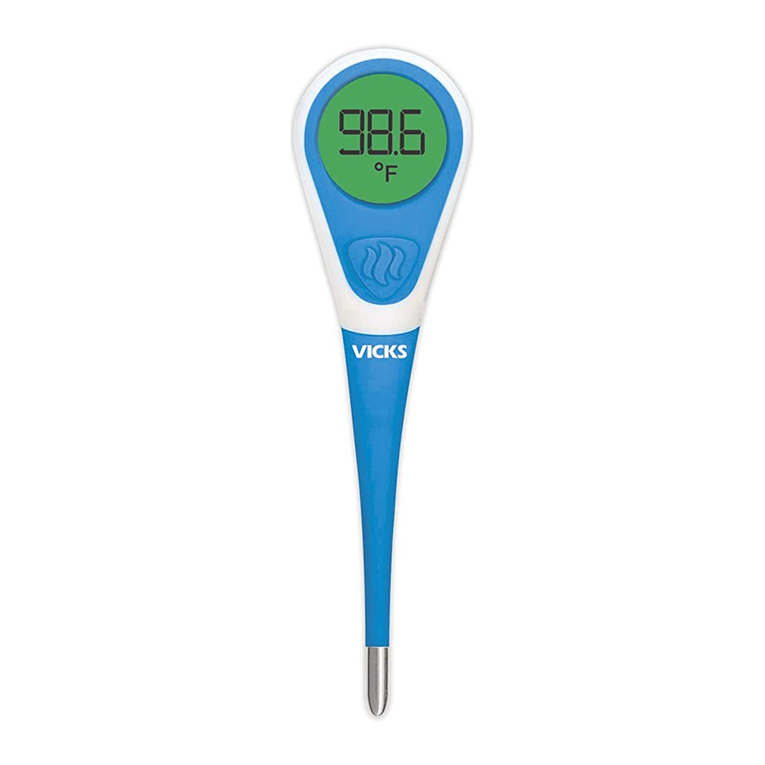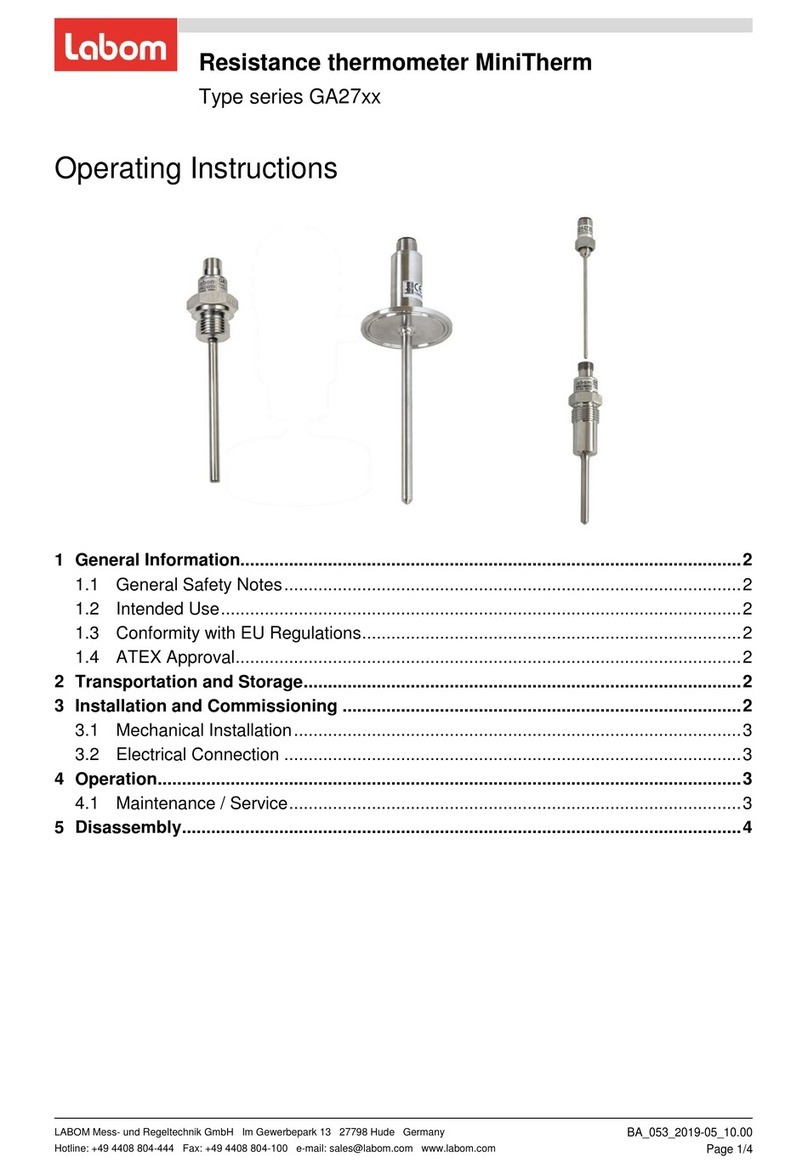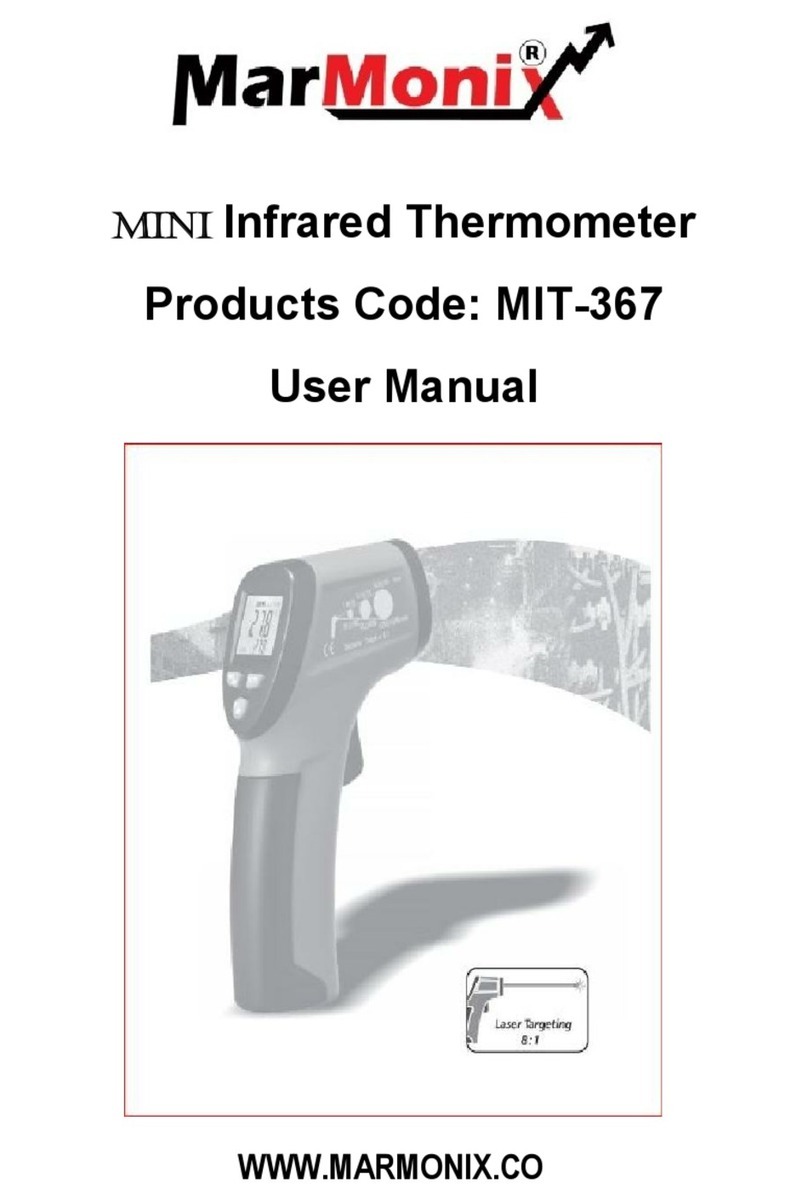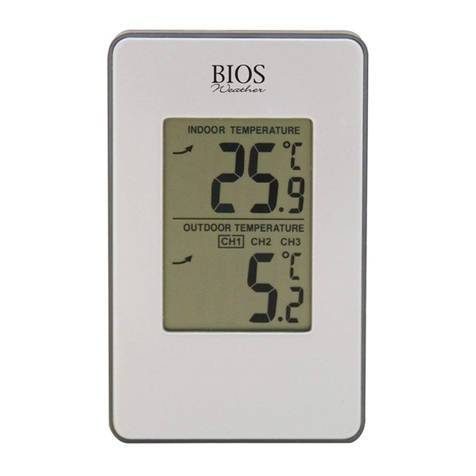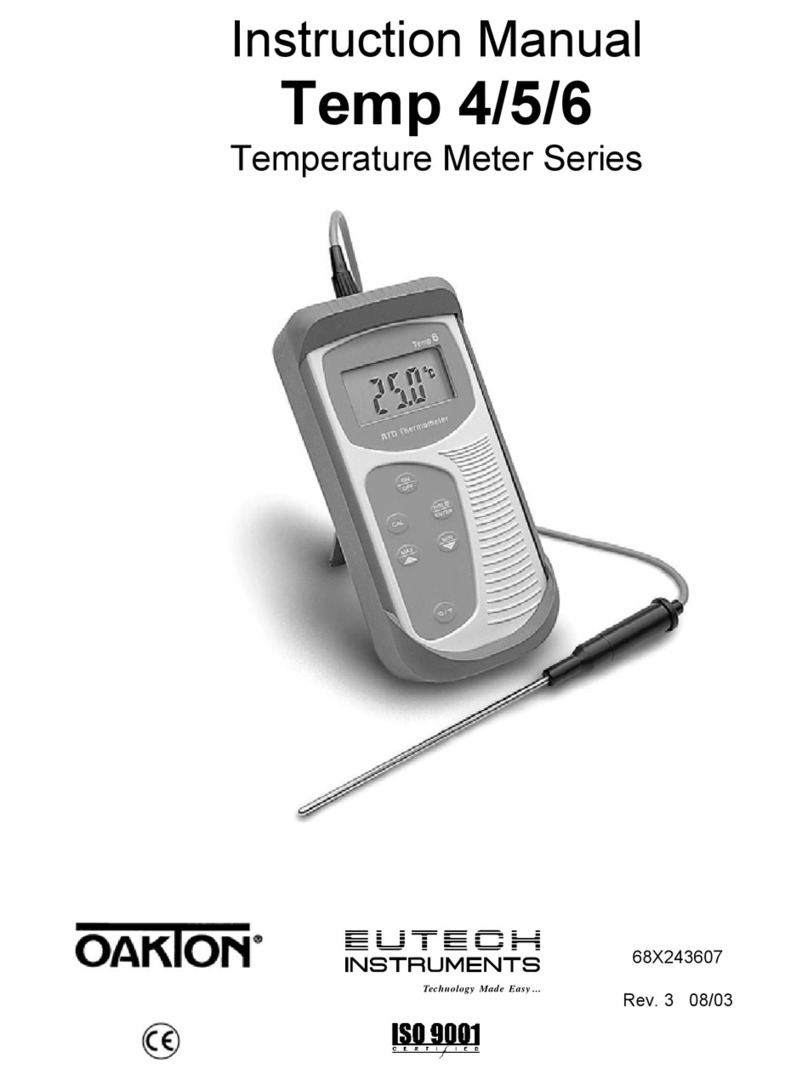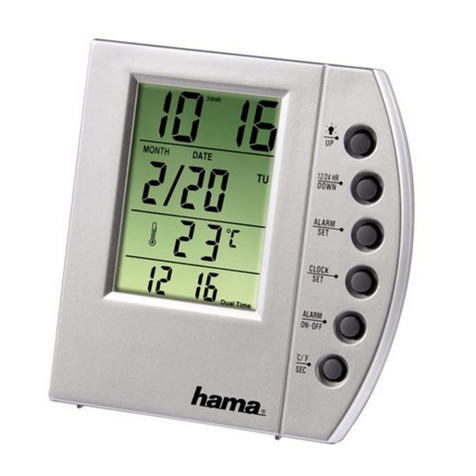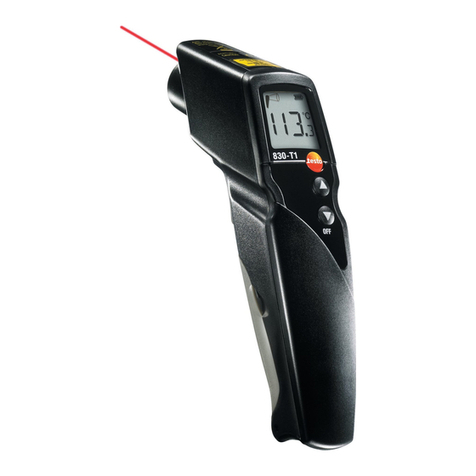promesstec WTR 230 User manual

Version 3.1.1
promesstec GmbH I Niedersachsenstraße 4 I D-Schüttorf I Tel.:+49 (0)5923/ 90 229 0 I Fax:+49 (0)5923/ 90 229 29
E-Mail: zentrale@promesstec.de I Internet: www.promesstec.de
User manual
Resistance thermometer WTR 230

2
promesstec GmbH I Niedersachsenstraße 4 I D-Schüttorf I Tel.:+49 (0)5923/ 90 229 0 I Fax:+49 (0)5923/ 90 229 29
E-Mail: zentrale@promesstec.de I Internet: www.promesstec.de
Content
1. General................................................................................................................ 4
1.1 Description measuring principle......................................................................4
1.2 Overview representation.................................................................................4
1.3 Drawings, shortcut..........................................................................................5
2. Transport, Packaging, Storage............................................................................ 5
2.1 Transport........................................................................................................5
2.2 Packaging.......................................................................................................5
2.3 Storage...........................................................................................................5
3. Safety instructions.............................................................................................. 6
3.1 Intended use of the product............................................................................6
3.2 Stuff qualification............................................................................................6
3.3 Special hazards..............................................................................................6
4. Starting operation............................................................................................... 7
4.1 Connection .....................................................................................................7
4.2 Mechanical assembly.....................................................................................8
4.3 Electrical assembly.........................................................................................8
5. Putting into operation.......................................................................................... 8
5.1 Configuration DMU 50....................................................................................9
5.1.1 Windows Software „pmtKonfigTool“.........................................................9
5.1.2 pmtKonfigTool - Connection between WTR 230 DMU and PC..............10
5.1.3 pmtKonfigTool –read.............................................................................10
5.1.4 pmtKonfigTool –write ............................................................................10
5.1.5 pmtKonfigTool –factory settings............................................................10
5.1.6 Status.....................................................................................................10
5.1.7 Temperature ..........................................................................................11
5.1.8 Display...................................................................................................11
5.1.9 Fault current...........................................................................................11
5.1.10 4…20mA Current output ........................................................................11
5.2 Configuration KMU 100 ................................................................................11
5.2.1 Windows Software „PXU01“...................................................................12
5.2.2 “PXU01” - Connection between WTR 230 KMU and PC .......................12
6. Technical specifications.................................................................................... 13
6.1 Technical data DMU 50................................................................................13
6.2 Technical data KMU 100..............................................................................13

3
promesstec GmbH I Niedersachsenstraße 4 I D-Schüttorf I Tel.:+49 (0)5923/ 90 229 0 I Fax:+49 (0)5923/ 90 229 29
E-Mail: zentrale@promesstec.de I Internet: www.promesstec.de
6.3 Technical drawings.......................................................................................14
7. Dismounting, Return, Cleaning, Disposal......................................................... 15
7.1 Dismounting .................................................................................................15
7.2 Return...........................................................................................................15
7.3 Cleaning.......................................................................................................15
7.4 Disposal........................................................................................................15

4
promesstec GmbH I Niedersachsenstraße 4 I D-Schüttorf I Tel.:+49 (0)5923/ 90 229 0 I Fax:+49 (0)5923/ 90 229 29
E-Mail: zentrale@promesstec.de I Internet: www.promesstec.de
1. General
1.1 Description measuring principle
The WTR 230 is a temperature sensor with a connection housing made of polyam-
ide. The sensor is ideal as a duct sensor to reliably record temperatures in pipes
and ducts. Thanks to the robust housing made of polyamide, theWTR 230 can also
be used in aggressive environmental conditions in industry without any problems.
The WTR 230 is available both passively and with the KMU 100 head transmitter,
which has a 4..20mA output. The WTR 230 is also available with the DMU 50 meas-
uring transducer. In addition to a 4..20mA output, the DMU has a high-resolution
OLED display.
1.2 Overview representation
WTR 230-A1-A-1A3
Resistance thermometer WTR 230
Protective fitting/temperature sensor
Connection housing
M16 cable gland

5
promesstec GmbH I Niedersachsenstraße 4 I D-48465 Schüttorf I Tel.:+49 (0)5923/ 90 229 0 I Fax:+49 (0)5923/ 90 229 29
E-Mail: office@promesstec.com I Internet: www.promesstec.com
1.3 Drawings, shortcut
Warning!
A non-observance can cause injuries to persons and/or the demoli-
tion of the device. There can be a dangerous to life.
Attention!
A non-observance can cause a faulty operation of the device or lead
to property damage.
Information!
A non-observance can have influence on the operation of the device
or cause unintentional reactions of the device.
Danger!
When not observing the safety instructions, there is a risk of serious
or fatal injuries caused by electrical power.
Warning!
Possibly a dangerous situation can occur, which results in burns be-
cause of hot surfaces or liquids, if not avoided.
2. Transport, Packaging, Storage
2.1 Transport
Check the instrument for any damage that may have been caused during transpor-
tation. If, report them immediately. The temperature during transportation and stor-
age of the meter must be within the range of -10 °C to 50 °C.
2.2 Packaging
Do not remove packaging until just before mounting. Keep the packaging as it will
provide optimum protection during transport (e.g. change in installation site, sending
back).
2.3 Storage
For longer term storage avoid the following influences:
1. Direct sunlight or proximity to hot objects
2. Mechanical vibration, mechanical shock (putting it hard down)
3. Soot, vapour, dust and corrosive gases

6
promesstec GmbH I Niedersachsenstraße 4 I D-48465 Schüttorf I Tel.:+49 (0)5923/ 90 229 0 I Fax:+49 (0)5923/ 90 229 29
E-Mail: office@promesstec.com I Internet: www.promesstec.com
If possible store the device in its original package or an equivalent one
3. Safety instructions
More important safety instructions can be found in the individual
chapters.
3.1 Intended use of the product
The sensor has been designed and built solely for the intended use described here
and may only be used accordingly. The technical specifications contained in these
operating instructions must be observed. Improper handling or operation of the in-
strument outside of its technical specifications requires the instrument to be taken
out of service immediately and an inspection by the manufacturer. When the instru-
ment is transported from a cold into a warm environment, the formation of conden-
sation may result in the instrument malfunctioning. Before putting it back into oper-
ation, wait for the instrument temperature and the room temperature to equalise.
The manufacturer shall not be liable for claims of any type based on operation con-
trary to the intended use.
3.2 Stuff qualification
Improper handling can result in considerable injury and damage to
equipment. The activities described in these operating instructions
may only be carried out by skilled stuff who have the qualifications
described below. Keep unqualified stuff away from hazardous areas.
For installation and starting of the flow-meter the stuff has to be familiar with the
relevant regulations and directives of the country and must have the qualification
required. They must have knowledge on measurement and control technology, have
to be acquainted with electric circuits, are capable of carrying out the work described
and can independently recognize potential hazards. Depending on the operation
conditions of the application they have to have the corresponding knowledge, e.g.
of aggressive media.
3.3 Special hazards
For hazardous media such as oxygen, acetylene, flammable or toxic
gases or liquids, refrigeration plants, compressors, etc., in addition to
all standard regulations, the appropriate existing codes or regulations
must also be followed. If you do not observe the appropriate reg-
ulation, serious injuries and/or damage can occur!

7
promesstec GmbH I Niedersachsenstraße 4 I D-48465 Schüttorf I Tel.:+49 (0)5923/ 90 229 0 I Fax:+49 (0)5923/ 90 229 29
E-Mail: office@promesstec.com I Internet: www.promesstec.com
A protection from electrostatic discharge (ESD) is required. The
proper use of grounded work surfaces and personal wrist straps is
required when working with exposed circuitry (PCB, printed circuit
boards), in order to prevent static discharge from damaging sensitive
electronic components.
There is a danger of death caused by electric current. Upon contact
with life parts, there is a direct danger of death. Electrical instruments
may only be installed and connected by skilled electrical personnel.
Operation using a defective power supply unit (e.g. short circuit from
the mains voltage to the voltage output) can result in life-threatening
voltages at the instrument.
Residual media in dismounted instruments can result in a risk to per-
sonnel, the environment and equipment. Take sufficient precaution-
ary measures. Do not use this instrument in safety or Emergency
Stop devices. Incorrect use of the instrument can result in injury.
Should a failure occur, aggressive media with extremely high tem-
perature and under high pressure or vacuum may be present at the
instrument.
4. Starting operation
4.1 Connection
WTR 230 passive WTR 230 with DMU 50

8
promesstec GmbH I Niedersachsenstraße 4 I D-48465 Schüttorf I Tel.:+49 (0)5923/ 90 229 0 I Fax:+49 (0)5923/ 90 229 29
E-Mail: office@promesstec.com I Internet: www.promesstec.com
WTR 230 with KMU 100
4.2 Mechanical assembly
-For adaptation in your process, only use the welded sockets and process con-
nections from promesstec. This is the only way we can promise you an optimal
measuring point.
-After installing the sensor, check the tightness of the measuring point.
4.3 Electrical assembly
The electrical installation must be carried out in a de-energized state.
- Open the case
- Insert the connection cable into the cable entry (screw connection). Be careful
not to damage the seal on the cable gland.
- Connect the connecting cables according to your task.
- If a measuring transducer is used, it can be configured via the respective inter-
face.
- Screw the device cover back on and switch on the power.
After installing the sensor, check the tightness of the housing and after installing the
connecting cable, check the tightness of the screw connection (cable entry).
5. Putting into operation
Before switching on the device, you should check whether the sen-
sor has been installed and wired correctly.

9
promesstec GmbH I Niedersachsenstraße 4 I D-48465 Schüttorf I Tel.:+49 (0)5923/ 90 229 0 I Fax:+49 (0)5923/ 90 229 29
E-Mail: office@promesstec.com I Internet: www.promesstec.com
5.1 Configuration DMU 50
If the WTR 230 is used with a DMU 50, the DMU settings can be read out, graphically
displayed and changed using the Windows software “pmtKonfigTool”. The following
explains how to configure the DMU with the “pmt-KonfigTool” software.
5.1.1 Windows Software „pmtKonfigTool“
The current settings of the DMU can be read and changed using the “pmtKonfigTool”
software. The application installation file can be downloaded from the website
www.promesstec.de.
The configuration options include, among other things, the display orientation, the
scaling of the current output and the overflow and underflow behavior of the measur-
ing range. In addition, the status, the measured value and the current value are read
out in real time.

10
promesstec GmbH I Niedersachsenstraße 4 I D-48465 Schüttorf I Tel.:+49 (0)5923/ 90 229 0 I Fax:+49 (0)5923/ 90 229 29
E-Mail: office@promesstec.com I Internet: www.promesstec.com
5.1.2 pmtKonfigTool - Connection between WTR 230 DMU and PC
Loosen the cover of the WTR 230 to access the USB C interface of the DMU. Con-
nect the transmitter to the PC using a standard USB C cable.
ATTENTION: WTR 230 restarts after connecting via USB! Now start the Windows
software “pmtKonfigTool”.
To access the display, the correct COM port must first be selected. All COM ports are
listed in the “Port” drop-down list. The button updates the drop-down list. As soon as
a connection has been successfully established, the status changes to “Connected”
and the name of the connected device is displayed.
5.1.3 pmtKonfigTool –read
As soon as a connection to the DMU has been established, the settings are read and
displayed in the software. The status, temperature and current value are continuously
updated. It is also possible to press the “Read” button to read and display all settings
again.
5.1.4 pmtKonfigTool –write
To change the DMU settings, the desired values must be entered into the Windows
software and the appropriate options selected. However, the settings are only applied
once the “Write” button has been pressed. If the writing process cannot be carried out
successfully, the old DMU settings will be displayed again.
5.1.5 pmtKonfigTool –factory settings
By pressing the “Factory settings” button, all parameters and settings are reset to the
delivery status.
Factory settings: Display: 0°
Fault current: activated
Measuring range min.: -30.0 °C
Measuring range max.: +70.0°C
5.1.6 Status
Overall, the DMU can assume four different statuses, which provide information
about the current loop and the measurement of the current.

11
promesstec GmbH I Niedersachsenstraße 4 I D-48465 Schüttorf I Tel.:+49 (0)5923/ 90 229 0 I Fax:+49 (0)5923/ 90 229 29
E-Mail: office@promesstec.com I Internet: www.promesstec.com
Ok: The DMU works perfectly
Cable break: There is a cable break in the connected PT1000
Underflow: The measured temperature is smaller than the smallest value
that can be transmitted with the 4..20mA interface
Overflow: The measured temperature is greater than the largest value that
can be transmitted with the 4..20mA interface
Error evaluation: There is an error in the evaluation of the PT1000
5.1.7 Temperature
The currently measured temperature is displayed in real time under the “Tempera-
ture” tab.
5.1.8 Display
Under Orientation, the orientation of the display can be rotated by 180°
5.1.9 Fault current
The overflow and underflow function can be activated or deactivated using the “Un-
derflow/Overflow” check box, which can be found under “Error current”. If the function
has been activated, the DMU outputs a current of 20.5mA when the measured tem-
perature exceeds the maximum temperature of the 4..20mA loop and 3.5mA when
the measured temperature falls below the minimum temperature of the 4..20mA loop.
If the function is deactivated, a current of 20mA and 4mA flows in the event of over-
shooting or undershooting. Regardless of the overflow and underflow function, a cur-
rent of 21mA always flows if there is a cable break in the temperature sensor
(PT1000).
5.1.10 4…20mA Current output
Under the “4..20mA current output” tab, the current of the current loop is displayed in
real time and the scaling of the loop is configured. To do this, the minimum tempera-
ture value for 4mA and the maximum temperature value for 20mA must be specified.
5.2 Configuration KMU 100

12
promesstec GmbH I Niedersachsenstraße 4 I D-48465 Schüttorf I Tel.:+49 (0)5923/ 90 229 0 I Fax:+49 (0)5923/ 90 229 29
E-Mail: office@promesstec.com I Internet: www.promesstec.com
If the WTR 230 is used with a KMU 100, the settings of the KMU can be read and
changed using the Windows software “PXU01”. The PXU01 parameterization soft-
ware kit is required for this. This contains the Windows software “PXU01” on CD, an
interface converter (USB adapter) and a plug-in adapter for the SME. The following
explains the configuration of the SME with the “PXU01” software.
5.2.1 Windows Software „PXU01“
The current settings of the SME can be read and changed using the “PXU01” soft-
ware. The application installation file is provided via a CD or optionally via a down-
load link. To receive the link, contact promesstec GmbH.
The configuration options include, among other things, scaling the current output.
The measured value is also read out in real time.
5.2.2 “PXU01” - Connection between WTR 230 KMU and PC
Loosen the cover of the WTR 230 to access the programming interface of the KMU.
Connect the KMU to the PC using the plug adapter and interface converter included
in the PXU01 parameterization software kit.
In order to access the device, a connection must first be established in the applica-
tion. The KMU settings can then be read and changed.

13
promesstec GmbH I Niedersachsenstraße 4 I D-48465 Schüttorf I Tel.:+49 (0)5923/ 90 229 0 I Fax:+49 (0)5923/ 90 229 29
E-Mail: office@promesstec.com I Internet: www.promesstec.com
6. Technical specifications
Protective fitting material: stainless steel 1.4571 (V4A)
Sensor length: freely selectable
Connection housing: plastic polyamide
Dimensions: 58 x 64 x 34 mm
Protection class: IP 65 according to DIN 60529
Temperature range: -50°C to +130°C
(Deviation when using a measuring transducer)
6.1 Technical data DMU 50
Operating temperature: -30 °C..+70 °C
Operating voltage: UB = 10..35 V DC
Current requirement: 7.3 mA (UB=24V) + 4..20mA output
Input: PT1000 2-wire
Measuring range max. -100°C..+650°C
Measuring span min.: 10 K
Measuring deviation: <+-0.1% of the final value
Output: 4..20mA 3-wire (underflow 3.5mA, overflow
20.5mA)
Sensor break: 21mA
Standard configuration: 4 mA = -40 °C, 20 mA = 70 °C (wide temperature
range can be parameterized)
Max. permissible load: Rmax=[(UB –6V) / 0.021 A] Ω
Display: high-resolution OLED display 0.96 inches
Orientation display: 0° or 180°
Display digits: 4 digits
Display range: -99.9 to +999.9°C
Configuration interface: USB Type C
Electrical connection: 6 screw terminals 1.5mm2
Configuration: Commercially available USB C cable (no program-
ming adapter necessary)
Windows application for configuration (“pmt-Konfig-
Tool”)
6.2 Technical data KMU 100
Operating temperature: -40 °C..+85 °C
Operating voltage: UB = 10..35VDC
Current requirement: 4..20mA output
Input: PT100 2, 3, 4 wire
Measuring range max. -200°C..+650°C

14
promesstec GmbH I Niedersachsenstraße 4 I D-48465 Schüttorf I Tel.:+49 (0)5923/ 90 229 0 I Fax:+49 (0)5923/ 90 229 29
E-Mail: office@promesstec.com I Internet: www.promesstec.com
Measuring span min.: 10 K
Measuring deviation: <+-0.1% of the final value
Output: 4-20mA (underflow 3.5mA, overflow 20.5mA)
Sensor break: 21mA
Standard configuration 4mA = -50°C, 20mA = 150°C (wide temperature
range can be parameterized)
Ambient temperature: Operating temperature -40°C..85°C
Electrical connection: 6x screw terminals 1.5mm²
Configuration: PXU01 programming adapter
Windows application for configuration (“PXU01”)
6.3 Technical drawings

15
promesstec GmbH I Niedersachsenstraße 4 I D-48465 Schüttorf I Tel.:+49 (0)5923/ 90 229 0 I Fax:+49 (0)5923/ 90 229 29
E-Mail: office@promesstec.com I Internet: www.promesstec.com
7. Dismounting, Return, Cleaning, Disposal
7.1 Dismounting
Residual media in dismounted instruments can result in a risk of per-
sonnel, the environment and equipment. Take sufficient precaution-
ary measures.
There is a risk of burns. Let the instrument cool down sufficiently
before dismounting. During dismounting there is a risk of danger-
ously hot pressure media escaping.
Only disconnect the resistance thermometer once the system has
been depressurised.
7.2 Return
When returning the instrument, use the original packaging or a suit-
able package.
To avoid a damage, use for example antistatic plastic film, shock-
absorbent material, a marking as highly sensitive measuring instru-
ment.
7.3 Cleaning
Before cleaning the instrument disconnect the electrical connection.
Clean the instrument with a moist cloth. Electrical connections must
not come into contact with moisture. Wash or clean the dismounted
instrument before returning it in order to protect personnel and the
environment from exposure to residual media.
Residual media in dismounted instruments can result in a risk to
persons, the environment and equipment. Take sufficient precau-
tionary measures.
7.4 Disposal
Dispose instrument components and packaging materials in accord-
ance with the respective waste treatment and disposal regulations
of the region or country to which the sensor is supplied.
Other manuals for WTR 230
1
Table of contents
Other promesstec Thermometer manuals
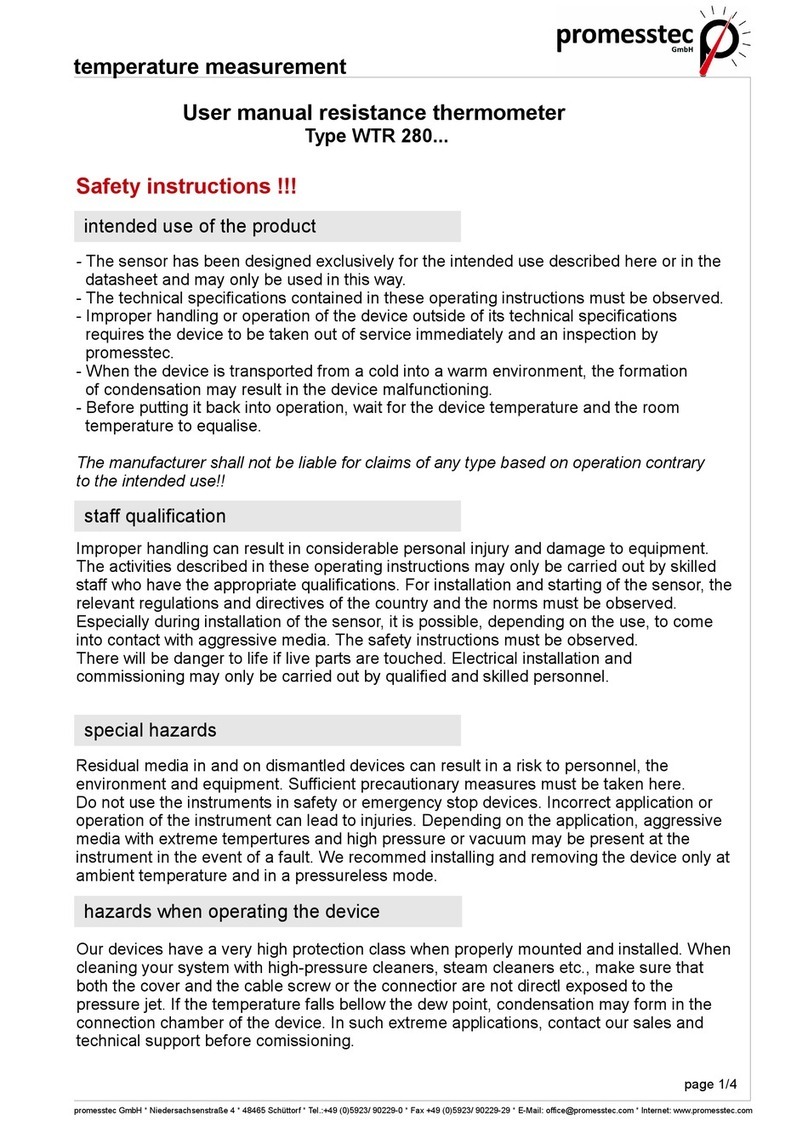
promesstec
promesstec WTR 280 Series User manual

promesstec
promesstec WTR 190 How to use

promesstec
promesstec WTR 270 Series User manual

promesstec
promesstec WTR 290 Series User manual

promesstec
promesstec WTR 230 User manual
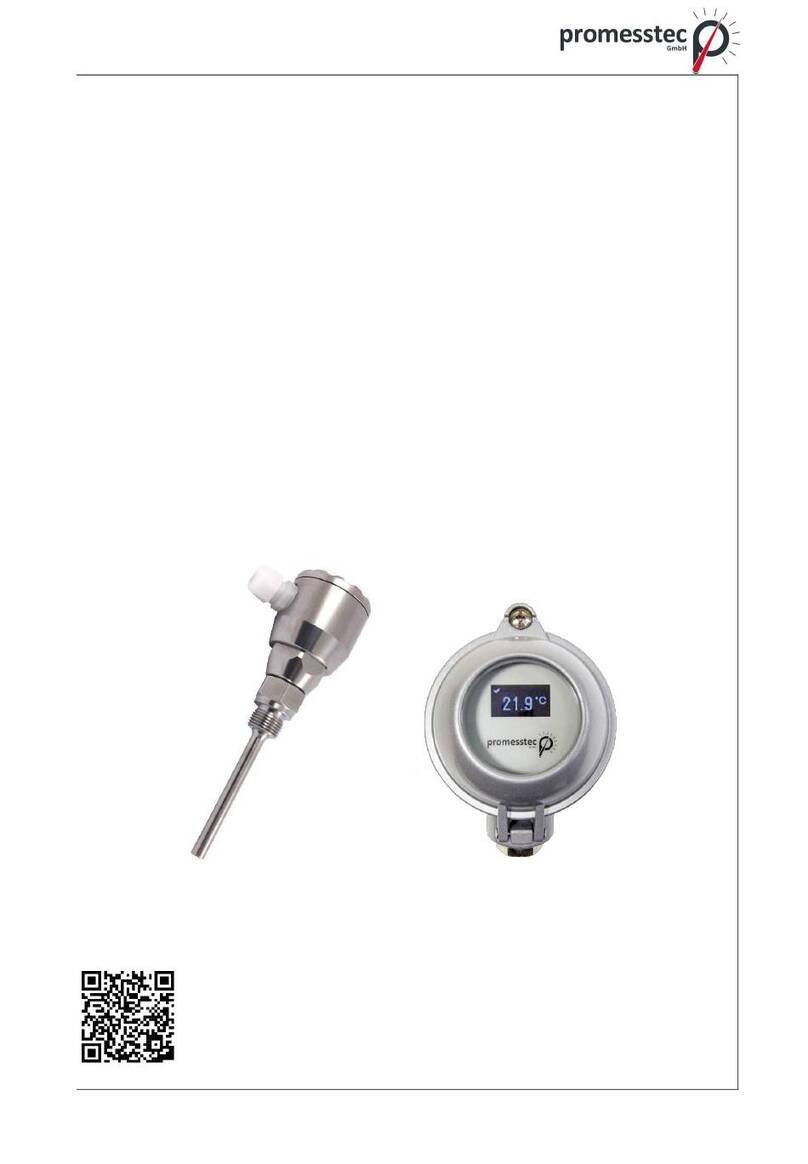
promesstec
promesstec WTR 120 User manual
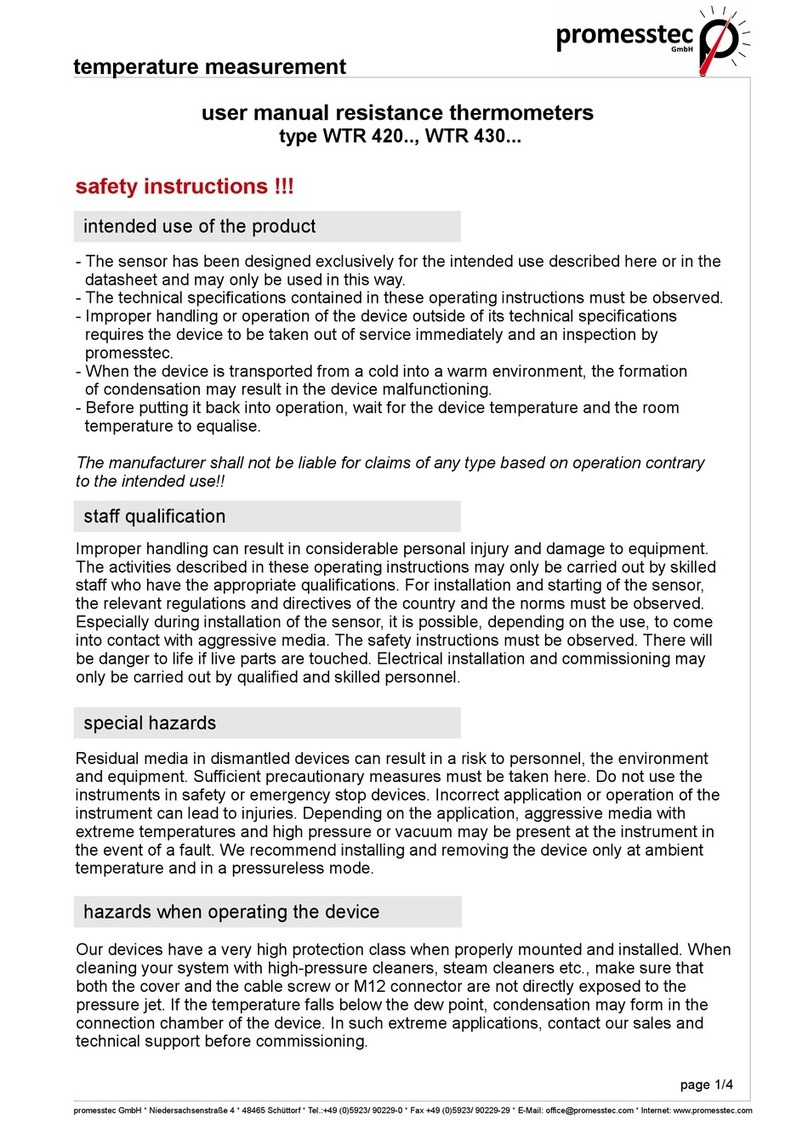
promesstec
promesstec WTR 420 Series User manual

promesstec
promesstec WTR 190 User manual

